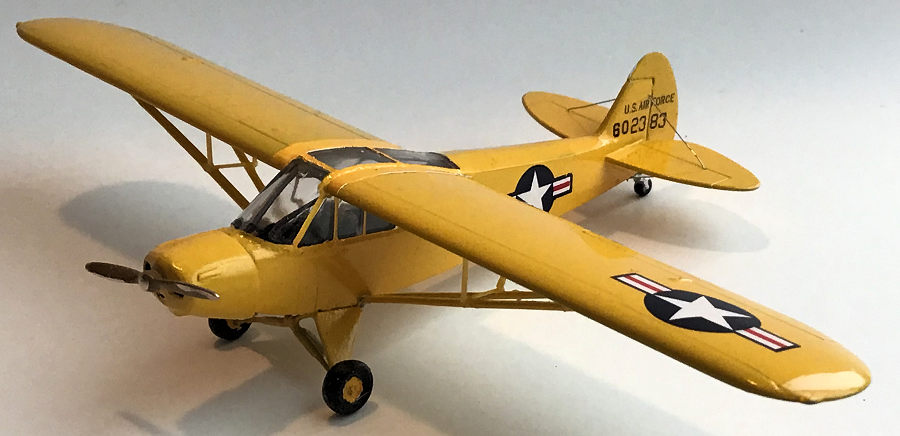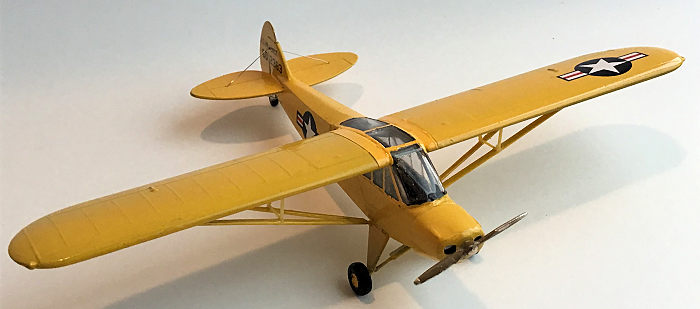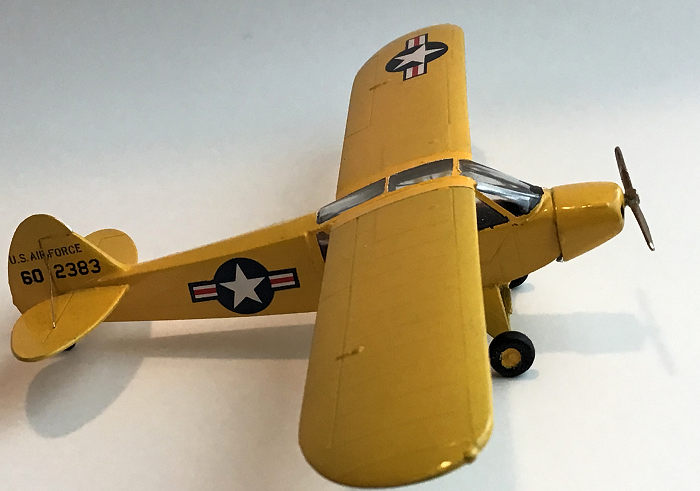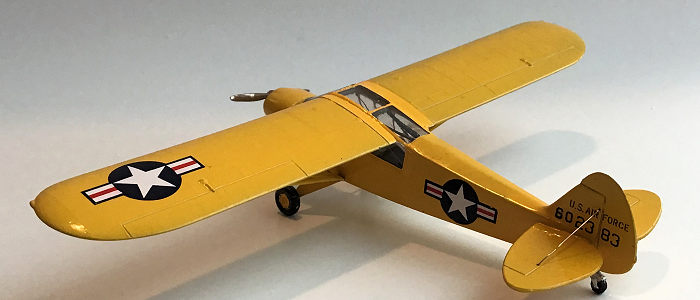
KP 1/72 Piper L-18C
| KIT #: | 0061 |
| PRICE: | around $25.00 |
| DECALS: | One option |
| REVIEWER: | Joel Hamm |
| NOTES: |

| HISTORY |
 Iconic
is one of those words that has been over-used into meaninglessness, but it still
is the best adjective to describe Piper Aircraft’s line of high wing “rag and
tube” lightplanes. Webster’s defines the term as “..widely recognized for
excellence…”, which must be true since Cubs started out in the 1930’s and are
still in production. The US military agreed, buying a handful for the Army and
Air Force to use as trainers, utility craft, liaison, spotter, and
what-have-you.
Iconic
is one of those words that has been over-used into meaninglessness, but it still
is the best adjective to describe Piper Aircraft’s line of high wing “rag and
tube” lightplanes. Webster’s defines the term as “..widely recognized for
excellence…”, which must be true since Cubs started out in the 1930’s and are
still in production. The US military agreed, buying a handful for the Army and
Air Force to use as trainers, utility craft, liaison, spotter, and
what-have-you.
| THE KIT |
For a good many
years the Czech KP company has been producing their own line of Cubs in 1/72
scale. They issued the L-4 military version of the civilian J-3 boxed with
wheels, skis, and floats, in a number of markings.
 About a
year ago the Super Cub was released in German and Israeli Air Force markings, as
well as civil liveries of several countries. Except for decals and marking
guides, parts are apparently included in one box for all these variants.
Duplicate wings, cowls, propellers, and other bits are on one set of sprues.
About a
year ago the Super Cub was released in German and Israeli Air Force markings, as
well as civil liveries of several countries. Except for decals and marking
guides, parts are apparently included in one box for all these variants.
Duplicate wings, cowls, propellers, and other bits are on one set of sprues.
These kits may be short run, but the molding quality equals or exceeds the ballyhooed Hasegawa / Tamiya standard. Crisp, minute detail; filler-free fit; absence of flash, seam lines, sink holes or ejector blemishes; hard, homogenous styrene. They have even begun to sprout locator pins and holes. Transparencies deserve particular praise. The Czechs seem to be privy to some extraterrestrial technology that creates exceptionally clear, smooth, and distortion free windows and windshields in near scale thickness.
| CONSTRUCTION |
 A
greenhouse so easily seen through deserves interior furnishings within to be
seen. Everything needed comes in the box, but some scrounged or scratch-built
pieces work better. Seatbelts are on the decal sheet. I found some PEB’s for the
front seat and used tape for the back. Bracing tubes are too thick and burdened
with injection gates. Stretching them from sprue is easier, neater, and more
realistic. Stretching them from black sprue avoids the need to paint. Minor
correction: The instructions show the apex of the aft V strut facing forward. It
should point backward with the arms attached at the wing root. A few additional
lengths of tubing need to be added. GOOGLE Images has enough interior views to
show where.
A
greenhouse so easily seen through deserves interior furnishings within to be
seen. Everything needed comes in the box, but some scrounged or scratch-built
pieces work better. Seatbelts are on the decal sheet. I found some PEB’s for the
front seat and used tape for the back. Bracing tubes are too thick and burdened
with injection gates. Stretching them from sprue is easier, neater, and more
realistic. Stretching them from black sprue avoids the need to paint. Minor
correction: The instructions show the apex of the aft V strut facing forward. It
should point backward with the arms attached at the wing root. A few additional
lengths of tubing need to be added. GOOGLE Images has enough interior views to
show where.
The prescribed method can be improved upon for fixing wings to fuselage. Joining wing panels to canopy then to body, as shown, makes it difficult to paint, mask, and fit the greenhouse. Instead, the attachment rods should be cut from the starboard wing, then holes drilled in both wing roots to accept stub spars inserted through the canopy, once that part has been mated to the fuselage.
| COLORS & MARKINGS |
In an earlier review I mentioned a love-at-first-use with laser cut canopy paint masks; so I sprung a few bucks for a set from Peewit.
Yellow requires an opaque white undercoat. Tamiya surfacer used to be my go-to; but the stuff can be finicky and smells awful. Testors Custom Lacquer flat header white does a better job and dries n seconds. Over that went several coats of Square Bottle Brand yellow.
 Finding US
insignia and Army markings in the decal cache promised to be easy; but promises
are easily broken. When a pair of properly sized U.S. Air Force decals tumbled
out I settled for those. Tail codes are bogus by only a few digits.
Finding US
insignia and Army markings in the decal cache promised to be easy; but promises
are easily broken. When a pair of properly sized U.S. Air Force decals tumbled
out I settled for those. Tail codes are bogus by only a few digits.
Since the markings were so few and far between, rather than spray-coating the whole she-bang with Future, I brushed a thin layer over the decals. WARNING! to anyone planning to use the Israeli scheme. The larger Mogen David insignia called for on the fuselage flanks are missing from the decal sheet, which has only the smaller roundels sized for the wings.
Wing struts need a bit of shortening, depending on how much dihedral got glued into the wing join (should be none). Cabane struts are best made of stretched sprue. Stretching them from yellow plastic again avoids painting. Tail bracing was made from surgical wire. Prop could be wood without a spinner or metal with.
| CONCLUSIONS |
They call me Mellow Yellow (quite rightly).
18 December 2018
Copyright ModelingMadness.com
If you would like your product reviewed fairly and fairly
quickly, please
contact
the editor or see other details in the
Note to
Contributors. Back to the Main Page
Back to the Review Index Page
Back to the Previews Index Page